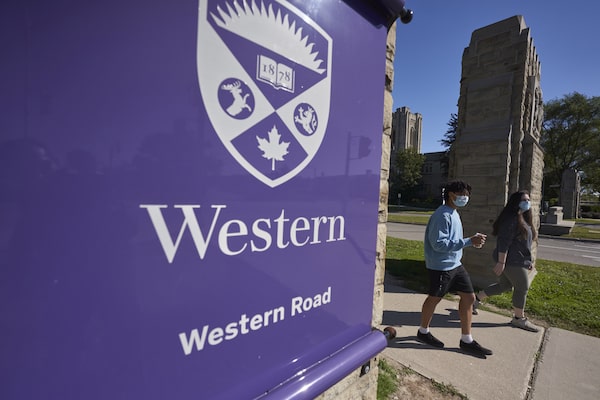
Students walk across campus at Western University in London, Ont., on Sept. 19, 2020.Geoff Robins/The Canadian Press
Universities across Canada are taking divergent approaches to COVID-19 mandates, as students and faculty return to classrooms in the third academic year to begin during the pandemic.
Last fall, most postsecondary institutions across the country had extensive requirements for return to in-person classes, including mandatory vaccinations and indoor masking for students, faculty and staff coming to campus. That is no longer the case this fall, as universities are making individual decisions based on relaxed provincial public-health guidelines.
Western University in London, Ont., has mandated medical-grade mask wearing indoors and is the only major university to require all students to have received three vaccine doses. By contrast, most universities in British Columbia will require neither vaccinations nor masking, while the University of Toronto has required only students living in residence to be vaccinated.
Some institutions have chosen to maintain mask mandates, such as Dalhousie University, the University of New Brunswick and Mount Allison University in the Maritimes, or the University of Windsor in Ontario. At McGill University, masks are only required on communal public transport and the shuttle buses between the downtown and Macdonald campuses, but are not mandatory on other campus locations.
Such different university approaches have been met with concern from some faculty and students, who believe restrictions are either too lax or too strict. For example, Lynne Marks, president of the University of Victoria Faculty Association and a professor in the history department, said staff there want at minimum a mask mandate in classrooms. Guidelines issued by the province’s public-health authority do not require them in any public space, including classrooms.
“This is happening in a number of universities across Canada. However, since the university is not willing to exceed PHO guidelines this is very unlikely to happen here,” Prof. Marks said. In its public-health guidelines for postsecondary schools, the BC Centre for Disease Control says “use of face coverings is a personal choice.”
Prof. Marks said that in March the university’s senate voted in favour of maintaining a mask mandate but was overturned by vote of the university’s board of governors. The board was not able to answer questions from The Globe and Mail.
Denise Helm, acting executive director for university communications and marketing at the University of Victoria, said in a statement the school has “always followed all the public health orders and implemented all of the health and safety measures required by the Provincial Health Officer.”
At Western University, meanwhile, students on Aug. 27 organized a campus protest against the COVID vaccine mandate – the strongest in the country – in hopes of pushing public discussions with the university administration to change the fall term’s measures. Hundreds of people attended, briefly blocking traffic along the university.
In a statement to The Globe, Florentine Strzelczyk, Western’s provost and vice-president, academic said that the university consulted with medical experts and members of the Western community to create its COVID policy for the semester.
“We are taking these pro-active measures to protect in-person learning and our vibrant on-campus experience,” Ms. Strzelczyk said.
A study published on Aug. 5 by Boston University researchers found that where mask mandates were required in classrooms and a vaccine mandate was required for the university community, “in-person learning was not contributing to the overall spread of SARS-CoV-2 in the campus community.”
Another study from August, 2021, by University of Bristol researchers says intervention strategies such as masking can reduce the transmission of COVID-19 in university settings. The study predicts that without “additional control measures,” 15 per cent of students “could be infected during the first term.”
In Manitoba, the University of Manitoba is keeping its existing mask mandate for the fall term, requiring all in the university community when indoors on campus to wear either a three-ply medical mask or, as the university highly recommends, a KN95 mask.
Mark Torchia, vice-provost, teaching and learning, said the institution has based its mask mandate on the province’s epidemiology data for the summer months.
“We felt that for the health and safety of our large community, which is 40,000 staff and students coming back in the fall into large classes with 250 students in them, unmasked may not be the best approach,” Mr. Torchia said.
He added that most of the feedback that he has heard from the university community has been in appreciation for keeping the mask mandate on campus.
“People are seeing it as a positive step and they say if things improve, we can always change that to a mask recommended as opposed to a mask required.”
The University of Winnipeg on the other hand, announced on Aug. 15 that the university, beginning Aug. 17, would no longer require students, faculty, staff and visitors to wear masks on campus, though it is still highly recommended.
“We ask our community to exhibit compassion with respect to an individual’s choice regarding masking,” said Todd Mondor, president and vice-chancellor, and Jan Stewart, interim provost and vice-president academic, in the announcement.
Our Morning Update and Evening Update newsletters are written by Globe editors, giving you a concise summary of the day’s most important headlines. Sign up today.
 Joy SpearChief-Morris
Joy SpearChief-Morris